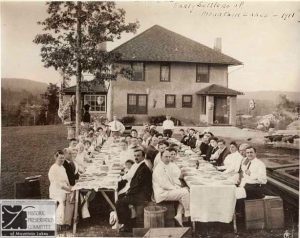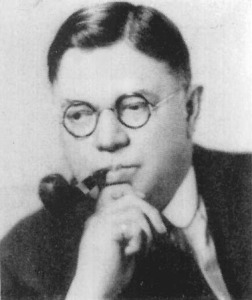 In the early part of the century, many new planned communities sprang up across the United States. Mountain Lakes Residential Park was one of these.
In the early part of the century, many new planned communities sprang up across the United States. Mountain Lakes Residential Park was one of these.
In 1910, Mountain Lakes was a rural woodland owned by a few families with names such as Righter, Grimes, Ball and Van Duyne. In the space of ten years, however, the entire face of Mountain Lakes changed from a wilderness of Dutch and English properties to a planned suburban community of large stucco houses now affectionately known as “Lakers.” During this single decade, the natural and architectural character of Mountain Lakes was developed. Since then, despite superficial changes, the original design imagined by the local engineer, Lewis Van Duyne, and executed primarily by developer, Herbert J. Hapgood, remains intact.
Today, some 90 years later, Mountain Lakes is still prospering, essentially intact, whereas other planned communities have lost their identities to intrusive development. Mountain Lakes ability to preserve its original design and character has been cited by professional planners as unique among American communities.
Fifteen years after Lewis Van Duyne surveyed the site for the nearby Boonton Reservoir, his practiced eye conceived a design for the development of the property adjacent to the city-bound branch of the Lackawanna Railroad. The site was a large tract of pristine land, one of rolling hills, woods, swamps and boulders. With the vague idea in mind of clearing the land and developing the site, he contacted developer and entrepreneur, Herbert J. Hapgood.
Hapgood, together with his landscape engineer, Arthur T. Holton, had a vision. He wanted to build homes in a popular, marketable mode. So he set out to build a gracious planned community to provide future homeowners with comfortable family-oriented homes.
As the first houses were built, residents ventured out from New York to escape the city heat. The first family, the Lawrence W. Luellens, moved into 46 Dartmouth Road on March 17, 1911. By the end of June, some fifty families had taken up residence. After the railroad station was completed in November of 1912, commuters were ready to take advantage of a direct train line to New York. By the end of 1912, two hundred Hapgood homes were sold and occupied. By 1923, approximately six hundred stucco houses were built to meet the overwhelming demand.
Hapgood was particularly influenced by the Arts and Crafts movement, at the height of its popularity in 1910 when he started building. He took many features of Gustav Stickley’s Craftsman architecture and philosophy and adapted them to his own designs. His houses were solid and boxy in appearance. They were large yet non-ostentatious homes with variations of colonial or neo-classical detail. All showed a clear relationship to the natural environment and promoted outdoor living. They were made to fit into the landscape, located on natural rather than graded terrain. Narrow roads were curved to fit the contours of the land. Local boulderstone was used extensively. The houses were designed to appeal to upper middle-class people who wanted to raise their families in a wholesome country environment filled with recreational opportunities and neighbors who would share their values.
An early advertisement features three distinct types of houses which were built on lots near the banks of Wildwood and Mountain Lakes, these lakes having been created for the residential park by three earthen dams. Hapgood named them the Manor House, the Semi-Bungalow and the Swiss Chalet. These styles were actually adaptations of the Foursquare House common in American towns in the early part of the twentieth century. In an article entitled, “The American Foursquare,” in The Old House Journal (February 1982), the architectural historian, Renee Kahn, defines the Foursquare as a two story house with “a square boxlike shape, and a low hipped roof with broad overhanging eaves. The exterior is unadorned, relying for impact on its shape and proportion. There is usually a porch extending the full width of the front elevation. Most often, there is a dormer in the roof facing front; sometimes there will also be dormers on the two side planes of the roof. Occasionally there will be a bay window or other architectural feature that breaks up the absolute flatness of the sides.”
The Hapgood model homes were early forerunners of the modern development, but each house was modified to suit individual tastes. To the basic styles of these houses, Hapgood added colonial and craftsman features. He reversed floor plans, and inter- changed architectural details.
The choice of materials used in the Lakers reflected both local availability and the fashion of the times. The fieldstone of the chimneys, walls and foundations was deposited regionally by the Wisconsin glacier ten thousand years ago. Chestnut paneling, ceiling cross beams and oak flooring were cut from trees by Hapgood at local sawmills using the timber cleared from the construction sites. Around 1910, builders began to show increased interest in stucco. Renee Kahn states, “Although its initial cost was slightly more than wood, it required little or no maintenance, and could be tinted delicate pastel colors when wet … A soft beige/brown appears to have originally been the most popular color.”
As is generally the case in planned communities, most of the trees and plants were removed for ease of construction. Trees and bushes which have sprung up since reflect the natural, informal landscaping that was prevalent at the time. The mountain laurel and rhododendron, for example, are specifically adaptive to our acid soil. Other decorative outdoor structures consisted of garden trellises, pergolas, gazebos, boathouses and tennis courts designed to enhance the enjoyment of the outdoors.
An unusual feature of the development was that so many houses, nearly 500 of them, were built by one developer. That so many of them have survived is also unusual. In fact, the 454 original houses still remaining is one of the largest collections of Craftsman-influenced houses in the United States.
The original design layout and the “Hapgoods” established the community as an ideal garden suburb and inspired subsequent development. The later homes were, for the most part, smaller and of various styles, but the original standards of quality in materials and craftsmanship were continued. Although there is no code in the Borough to control style of architecture, there exists nevertheless a certain homogeneity within the community derived in large part from the prominence of the old stucco Hapgood homes and the dominance of colonial styles among newer buildings.
In 1923, when Hapgood’s enterprise failed, the Belhall Company was formed to take control of undeveloped land and steps were taken for Mountain Lakes to become a separate municipality. It is significant that, at this time, a committee was formed to draw up possible boundaries for the new Borough. So it was, that only a little more than a decade after the first construction, boundaries were drawn that went to the Denville border on the west and to Intervale Road on the east, explicitly “in order to permit continuity in development.” This was recognition of the idea that Hapgood’s vision extended not only to the properties he owned but to others that were contiguous.
Also in the 1920’s, well after the Hapgood development was established, the Arthur D. Crane Company bought land from the St. Francis Health Resort and created the Lake Arrowhead development with its own distinctive type of architecture and design upon the land.
Immediately after World War II, a major new development occurred on a large, relatively flat tract of land between the railroad and Intervale Road. There the Fox Development Company erected some 67 smaller homes that filled an important demand for housing for returning veterans and their young families.
Two other events of major importance to the Borough were its acquisition in 1938 (toward the end of the Depression) of titles to most of the prime undeveloped building lots remaining in the Borough and, in 1952, the purchase of 250 acres of woodland around Crystal and Birchwood Lakes and up to the Tourne. Both of these acquisitions gave Mountain Lakes the opportunity to control its own destiny, to avert the intrusive over-development that destroyed so many other planned communities, and to maintain its unique character.
Today, the grand gardens have been simplified, houses have been renovated and the servants are gone. Still, the essential character of the Lakers in their environment remains. The rustic suburb of Mountain Lakes has maintained its unique character, environment and sense of place created in the two decades following its founding, fulfilling Hapgood’s vision of an ideal community. This town’s ability to regulate its growth and thereby control its destiny, cited as unique by Mel Scott in American City Planning Since 1890, is carried on today with renewed dedication to its original ideals.
The Character Of Mountain Lakes
Mountain Lakes is still a special community. You first become aware of it as you pass through the stone pillars at either end of town. You know it as you drive along its narrow curving roads and notice the large stucco Hapgoods — their pleasant family resemblance and yet their individuality.
You know it on a hot summer day as you leave Route 46 for Intervale Road — the temperature drops, the glare disappears, your heart gets a little lift — and you know you are home.
This character of the community, the sense of place, is intangible. It is something we all want to preserve, yet preservation of character cannot be done directly. It can only be done indirectly by maintaining the tangible elements that represent and reinforce this sense of place.
Some of these tangible elements are:
- The Natural Setting — Glacial terminal moraine, rolling hills, woods and lakes, boulderstone.
- The Design on the Land — The layout conceived by Hapgood and Holton, his landscape architect; landscape as the prime determinant of the original plan; emphasis on aesthetic use of topography and hydrology; design around the lakes.
- The Built Environment — Dominance of boulderstone in community buildings, foundations, walls, pillars; the houses — eclectic but with an all-important family resemblance; largely stucco with Arts and Crafts features; great congruity between landscape and architecture (simple, naturalistic and traditional).
- Continuity in Design and Lifestyle — Design integrity preserved even while the community undergoes change; newer homes fitted into the lots and layout of Hapgood’s original design; present road designs, watercourses and lakes the same as in the original community.
Why Mountain Lakes Houses Are Historically Significant
The period in which Herbert Hapgood designed was one of eclectic architectural styles, but his work shows a consistent debt to Craftsman architecture, tempered by a Colonial Revival influence. Craftsman architecture — now an area of growing interest and study — was one of several related styles that developed out of the English Arts and Crafts movement of the 19th century. Like the English movement, Craftsman architecture emphasized a simple approach to design, with an honest expression of the materials used. This truth and simplicity was a reaction against what was called the “excesses” of Victorian design. Or, as Gustav Stickley, the American proponent of the movement, stated in his monthly journal called The Craftsman, “beauty does not imply elaboration or ornament.”
We see the Craftsman attitude towards natural materials in Hapgood’s use of stucco, boulderstone exteriors with exposed wood details, and interiors characterized by sturdy oak floors, exposed beams and trim, chestnut paneling, and large brick and stone fireplaces. Built-ins and inglenooks are typical — comfortable, simple conveniences. These houses have a sense of volume to them and sit snugly into the landscape. The abundance of surrounding porches contributes to the emphasis on the horizontal, which keeps these houses so solidly anchored to the earth.
The Craftsman influence on Hapgood’s architecture is modified by the reliance on Colonial Revival design. Some of the innovative concepts are melded with the very salable, tried-and-true Colonial floor plans to produce houses that have been and still are called “comfortable houses,” great for family-centered lifestyles then and now.
Thus, rather than an idealistic and costly expression of a pure architectural style, the homes in Mountain Lakes combine practical features of several styles, but they remain very much a product of their time. They have a homogeneity as well as an architectural significance, but their significance lies more in the whole than in the sum of its parts. It is the collection of Craftsman-influenced homes located in a relatively small, planned community, not any particular home, that is important.
Around the turn of the century there was an increase in literature and physical experimentation in the design of the ideal garden suburb. Mountain Lakes was designed as a commuter community providing its residents with homes situated in a park-like setting, with curved roads and scenic vistas, encouraging outdoor lifestyles and shared community values.
Although a few other planned suburbs such as Llewellyn Park, before it, and Radburn, after it, have also survived, Mountain Lakes is one of the few towns designed in the 1910 decade that has survived and grown with its original goals and character intact.


